Diplomatic Bluebook 2018
Chapter 3
Japan's Foreign Policy to Promote National and Global Interests
2 Cultural and Sports Diplomacy
(1)Overview
MOFA and the Japan Foundation (JF) implement various projects, through introducing Japanese culture and sports overseas, to create positive images of Japan in foreign countries, boost the value of brands in Japan while encouraging deeper understanding of Japan, and foster individuals and groups knowledgeable about Japan for the future. For example, the “Cultural Projects of the Diplomatic Missions Overseas” introduce a wide range of Japanese culture, from traditional culture such as the way of tea and flower arrangement (Ikebana), to contemporary culture such as animation, manga, and fashion. Under the “Japan Brand Program,” MOFA has dispatched experts of various fields overseas to share Japan's outstanding cultural assets, experience and wisdom with other countries, as well as to establish Japan's national brand with stronger presence in the world. MOFA holds seminars, workshops and demonstrations reflecting each event's characteristics, and share values and experiences with the audience, paving the way for international exchanges. Currently, “All-Japan” efforts are also being made to boost the number of inbound foreign visitors through various overseas PR projects through communication via social networking services (SNS) and other means: promoting the regional diverse attractiveness.
Towards the success of the Olympic and Paralympic Games Tokyo 2020, it is also important to enhance Japan's presence in the field of sports. As part of the “Sport for Tomorrow (SFT)” program, MOFA is engaged in various initiatives including sports exchanges and sports promotion support projects overseas, the dispatch of sports instructors through the JICA volunteer program or the JF, and the provision of sporting equipment and development of facilities by utilizing the Cultural Grant Assistance. It also supports the Host Town Initiative that promotes mutual exchanges with the countries and regions participating in the Olympic and Paralympic Games Tokyo 2020.
In addition, in order to promote understanding and support for Japan and better understanding of Japan through Japanese studies, MOFA implements the following activities: provision of information on studying in Japan through Japan's diplomatic missions overseas; building alumni networks of the foreign nationals who have studied in Japan; cooperation for the JET Programme which invites young people from abroad to the local governments in Japan; exchange programs for youth and adults from Asia and North America; sending visiting professors to universities and research institutions overseas; and grant program for research activities.
Promoting Japanese language education overseas helps foster future leaders who will build a bridge between Japan and overseas, deepen understanding towards Japan, and lay a foundation for friendship with other countries. Therefore, MOFA engages in sending Japanese language specialists overseas, providing training for foreign Japanese language teachers in Japan, and developing Japanese language teaching materials through the JF.
In addition, by utilizing the budget allocated to the strategic communications, MOFA intends to continuously strengthen its support for Japan studies, expand the scope of people-to-people exchanges and sports exchange programs, and promote Japanese language education.
In cooperation with the United Nations Educational, Scientific and Cultural Organization (UNESCO), Japan has made earnest efforts to preserve the world's tangible and intangible cultural heritage. Moreover, Japan is actively taking part in promoting the international framework for safeguarding heritage through the World Heritage Convention, the Convention for the Safeguarding of the Intangible Cultural Heritage, etc. (see 3-4-2 (7) “Cooperation with the United Nations Educational, Scientific and Cultural Organization (UNESCO)” for details).
By promoting such cultural and sports diplomacy, MOFA contributes to introducing Japan's attractiveness overseas, and to increasing the number of foreign visitors to Japan.
(2) Culture Programs
It is important for Japan's diplomatic policies to be smoothly implemented in the international community to boost understanding towards Japan among individual foreign nationals who form the foundation of public opinion and policy making, as well as to make Japan's image even more positive. Based on this recognition, MOFA engages in promoting the diverse attractiveness of Japan through diplomatic missions overseas and the JF. As part of diplomatic activities to promote a better understanding of Japan and to cultivate pro-Japanese groups, the diplomatic missions overseas organize diverse cultural activities. For example, they plan and implement workshops on tea ceremony, flower arrangement, and origami, screening of Japanese films, Japanese music performances, martial arts demonstrations, exhibitions of traditional crafts, as well as Japanese speech contests. Moreover, Japanese pop culture such as anime and manga, as well as Japan's food culture, are being actively promoted in recent years.
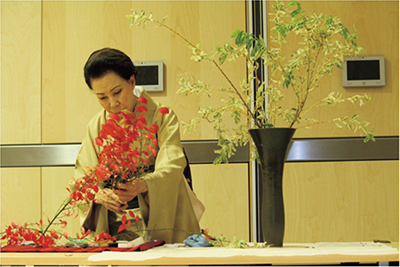 Ikebana demonstration/workshop (October 17 and 18, Riga, Latvia)
Ikebana demonstration/workshop (October 17 and 18, Riga, Latvia)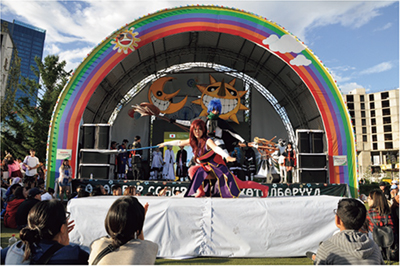 Japanese Culture/Pop Culture Festival (August 12, Ulaanbaatar, Mongolia)
Japanese Culture/Pop Culture Festival (August 12, Ulaanbaatar, Mongolia)Furthermore, MOFA conducts large-scale and comprehensive programs in commemorative years celebrating diplomatic events in cooperation with government and private organizations through mutual visits of dignitaries, various conferences, and public relations/cultural projects, with the aim of effectively promoting understanding about Japan. For example, a Japanese music performance, with the koto Japanese zither and shakuhachi flute, took place in 2017 to commemorate the 150th anniversary of the establishment of diplomatic relations between Japan and Denmark.
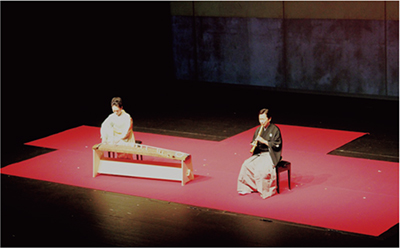 “The Harmonious Sound of Koto,” an anniversary concert for the 150th anniversary of the establishment of diplomatic relations between Japan and Denmark (June 15 and 16, Copenhagen, Denmark)
“The Harmonious Sound of Koto,” an anniversary concert for the 150th anniversary of the establishment of diplomatic relations between Japan and Denmark (June 15 and 16, Copenhagen, Denmark)In collaboration with MOFA and the diplomatic missions overseas, the JF runs interactive arts and cultural exchange projects to promote Japanese culture and arts in a variety of forms throughout the world. The JF also promotes and provides support for Japanese language education and research on Japan. During the Year of Japan-India Friendly Exchanges, the diversity of Japanese culture in a wide range of fields was showcased in India at the Japan Festival in autumn, including Japanese music, jazz, traditional Japanese dance, and a Japanese film festival. The events deepened the bonds of friendship between Japan and India through the medium of culture.
Furthermore, the Japan Foundation Asia Center is steadily implementing the “WA Project: Toward Interactive Asia through Fusion and Harmony” announced by Prime Minister Abe in December 2013, with main pillars of support for Japanese language education and interactive arts and cultural exchange projects. Through the “NIHONGO (Japanese language) Partners” program, which is the core project to support Japanese language education, 994 teaching assistants in total were dispatched to mainly secondary education institutions in ten countries in Southeast Asia, as well as China and Taiwan, and implemented the exchange program through the introduction of Japanese culture as well as Japanese language education by the end of 2017. As a result, many school officials who received the “NIHONGO Partners” highly evaluated the program, saying its activities contributed to increased motivation for students to learn.
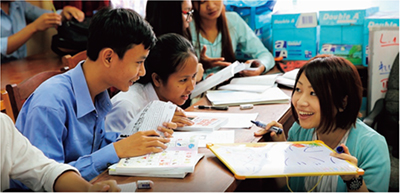 Activities of the NIHONGO Partners at their host institutions (January, Cambodia; Photo: Japan Foundation)
Activities of the NIHONGO Partners at their host institutions (January, Cambodia; Photo: Japan Foundation)In the interactive arts and cultural exchange program implemented by the Japan Foundation Asia Center, the largest Southeast Asia contemporary art exhibition ever held in Japan to date, entitled “SUNSHOWER: Contemporary Art from Southeast Asia 1980s to Now,” was held for the area of arts. In the area of film, efforts were made to promote film exchange through collaboration with the Tokyo International Film Festival, and through the Japanese Film Festival (JFF): Asia-Pacific Gateway Initiative. In the area of sports, a soccer exchange program was held in collaboration with the Japan Football Association (JFA) and J-League, among other initiatives.
 “SUNSHOWER: Contemporary Art from Southeast Asia 1980s to Now” Exhibition, Japan's largest exhibition of Southeast Asian contemporary art to date, mobilizing 350,000 people (July to October, Tokyo Venues: The National Art Center, Tokyo, and Mori Art Museum Photo taken by Kioku Keizo; Photo: Mori Art Museum)
“SUNSHOWER: Contemporary Art from Southeast Asia 1980s to Now” Exhibition, Japan's largest exhibition of Southeast Asian contemporary art to date, mobilizing 350,000 people (July to October, Tokyo Venues: The National Art Center, Tokyo, and Mori Art Museum Photo taken by Kioku Keizo; Photo: Mori Art Museum)The Japan International MANGA Award was launched by MOFA in 2007 with the aim of rewarding manga creators who have contributed to the spread of manga culture overseas. The 11th International MANGA Award of 2017 received 326 entries from 60 countries and regions, and the Gold Award went to a work from Colombia. Moreover, applications were received for the first time from the Netherlands, Kenya, Pakistan, and Belarus, making for a record number of countries and regions from which applications were received.
(3) People-to-People Exchange and Exchanges in the Area of Education and Sports
MOFA carries out a number of invitation projects to build personal connections and promote understanding of Japan by inviting foreign nationals who have a great influence on shaping public opinion and policy making process, and who are expected to play a leading role in various fields. Also, in the area of education and sports, MOFA carries out various activities to promote exchanges among a wide range of people. These projects not only promote mutual understanding and friendships but also enhance Japan's presence in the international community, which considerably benefits the national interest of Japan.
A Student Exchange Programs
MOFA actively introduces the attractiveness and opportunities of studying in Japan to foreign students through diplomatic missions overseas. It also implements application and selection procedures to accept competent students from around the world as the Japanese Government (MEXT) Scholarship students. Furthermore, it is making efforts to maintain relations with former foreign students who have returned to their home countries through Japan Alumni Associations and to foster pro-Japan individuals and groups.
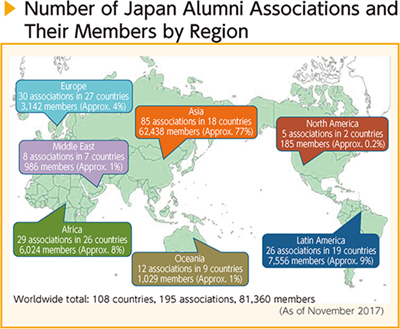
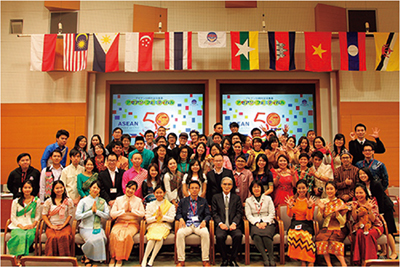 ASEAN Festival ASEAN 50 (organized by ASJA International) (December 17, National Olympics Memorial Youth Center, Tokyo; Photo: ASJA International)
ASEAN Festival ASEAN 50 (organized by ASJA International) (December 17, National Olympics Memorial Youth Center, Tokyo; Photo: ASJA International)B JET Programme (The Japan Exchange and Teaching Programme)
The JET Programme was launched in 1987 to improve foreign language education and promote international exchanges in local areas. In FY2017, a total of 5,163 people, including 1,906 new participants from 44 different countries, took part in the program and were dispatched all over Japan. This program is administered by local authorities, in cooperation with the Ministry of Internal Affairs and Communications (MIC), MOFA, the Ministry of Education, Culture, Sports, Science and Technology (MEXT), and the Council of Local Authorities for International Relations (CLAIR). They invite young foreign nationals to Japan and appoint them to posts in local governments and schools. MOFA is responsible for the application and selection process, pre-departure orientation, and support for the activities of the JET Alumni Association in 16 countries (JETAA has about 27,000 members). JETAA engages in activities to introduce Japan in various countries, and many former JET participants engage actively in various fields as pro-Japanese in different parts of the world. Former JET participants are valuable human/diplomatic assets for Japan.
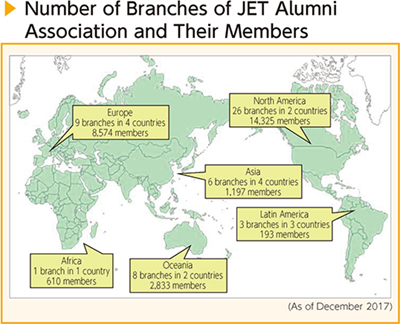
 JET participants prior to departure for Japan (July 7, Embassy of Japan in Singapore, Singapore)
JET participants prior to departure for Japan (July 7, Embassy of Japan in Singapore, Singapore)C Sport Exchange
Sports enable communication beyond languages and can be an effective tool for promoting friendly relations and understanding of Japan. While Japan draws more attention from the world as the host country of the Olympic and Paralympic Games Tokyo 2020, the Government of Japan has been implementing the “Sport for Tomorrow (SFT)” program as an international cooperation initiative through sports since January 2014. This program offers various sports exchanges, promotional support, and human development projects in different countries with the aim of spreading the value of sports among over 10 million people in more than 100 countries by 2020. Starting in FY2015, MOFA has been implementing “Projects for Sports Diplomacy Enhancement” to dispatch and invite athletes and instructors, provide equipment, and hold receptions at diplomatic missions overseas, among other initiatives. It also contributes to developing bilateral relations by implementing the programs more promptly and closely in response to requests from the foreign governments and sports associations. These SFT projects have enhanced the presence of those engaged in sports in Japan in the international sports community.
MOFA, in cooperation with organizations and individuals in the sports sector, is engaged in various projects that are related to sports. 2018 marks the year when FIFA holds the World Cup in Russia, which is held once every four years. This Column features an example of MOFA's international contributions in cooperation with the Japan Football Association, and an article by Tsuneyasu Miyamoto, the former captain of the Japanese national football team.
Cooperation with Sports Associations - Football Exchanges between Japan and Nepal -
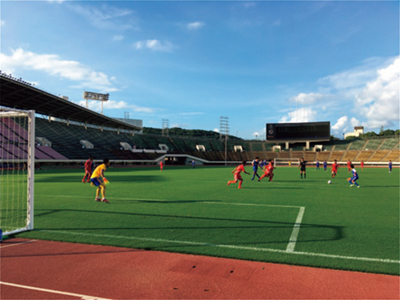 Exchange match with Kwansei Gakuin University
Exchange match with Kwansei Gakuin University(August, Hyogo Prefecture, Photo: Japan Football Association)
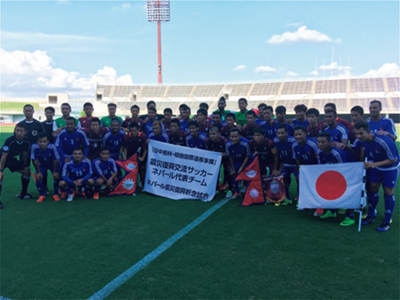 Disaster relief friendly match with Vissel Kobe U-18
Disaster relief friendly match with Vissel Kobe U-18(August, Hyogo Prefecture, Photo: Japan Football Association)
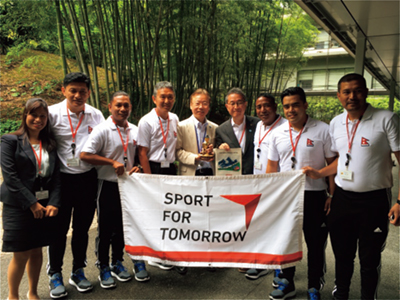 Courtesy call on MOFA from Nepalese football coaches
Courtesy call on MOFA from Nepalese football coaches(June, MOFA, Tokyo)
Occasionally, sports are described as a universal language shared across the world. In the field of sports, we often see people around the world engaged in exchange activities that transcend differences in nationality and language. Sports are commonly associated with victory or defeat, but this is possible only when there are people one can compete with.
Many of the Japan's sports associations not only provide support to help Japanese athletes improve their performance; but also actively contribute to the international community, from the perspective of boosting games and improving performance in the world. In this article, we will introduce an episode of contributions made through football, as an example of an initiative implemented jointly by a sports association and MOFA.
The Japan Football Association (JFA) provides active support to Asian countries with the vision of “giving children a bright future through football and contributing to the promotion and the development of Asian football.” One of its initiatives is the dispatch of coaches. From February 2017 to January 2018, JFA dispatched two Japanese coaches to Nepal. Although it was no easy task to organize external matches or conduct training overseas due to financial reasons and other factors, the two coaches strived every day to improve the football skills in Nepal.
As a part of this endeavor, MOFA invited five football coaches from Nepal to Japan in June 2017 under the Project for Sports Diplomacy Enhancement, which is a framework for promoting diplomacy by utilizing sports. This framework is realized through cooperation of MOFA, the sports associations and others that wish to implement international exchange programs. Launched in 2015, it is now in its third year in 2017. The five coaches who visited Japan commented in their report, “It was an invaluable experience to visit Japan which was ahead of putting an effort into training coaches in Asia, to observe coaches of the J. League clubs train athletes, and to try our hands at training Japanese athletes to receive feedback from JFA instructors on our coaching methods.”
Furthermore, in August, the Nepalese national team was invited to Japan as a part of the Japan-China Afforestation and Tree-Planting International Solidarity project. This project aims to raise awareness of the environment and disaster readiness for both Nepal, which experienced a major earthquake in 2015, and for Japan, which is also an earthquake-prone country. It also aims to promote mutual understanding through sports exchanges. During their stay, in addition to participating in football exchanges, the team visited disaster prevention facilities in Osaka and Hyogo Prefectures, where the Great Hanshin Earthquake had struck, and partook in tree-planting activities to commemorate the earthquake reconstruction exchange in Hyogo Prefecture. The Nepalese national team that visited Japan was grateful for the opportunity to improve football standards of Nepal through football exchanges, and expressed that they had learnt much with regards to knowledge about disaster readiness. Hence, the program was a meaningful bilateral exchange.
In the run-up to the Olympic and Paralympic Games Tokyo 2020, MOFA will continue to work through effective diplomatic measures that bring together different fields and sectors.
Building a Bridge Through Sports in the History of Ethnic Conflict -Reconciliation Through Sports-
Tsuneyasu Miyamoto, former captain of the Japanese national football team
■ A desire to nurture children who will become leaders of their towns, instead of nurturing professional athletes
“Is it feasible to create a youth sports academy for peaceful coexistence and intercultural living in Mostar, Bosnia and Herzegovina?”
This was the theme of the Master's thesis that I worked on in the FIFA Master course (a Master's degree conducted by FIFA), which I undertook after I retired as a professional football player. We proposed various themes in our group, and finally decided on this theme partly because there was a female student from Bosnia and Herzegovina in my group.
The armed conflict among different ethnic groups in Bosnia and Herzegovina ended in 1995 by the signing of the Dayton Accords. However, a sense of distrust remains deeply rooted among the ethnic groups even today, and it affects various aspects of daily life such as different educational curriculums among them.
Our activity places the focus on the acquisition of social values, by encouraging children to work together in teams through sports instead of dividing them by their different ethnic groups, and to respect others and understand diversity. The aim is for the children who have gone through this learning program to become future leaders of their towns.
■ Realization of the project through the cooperation of MOFA and JICA
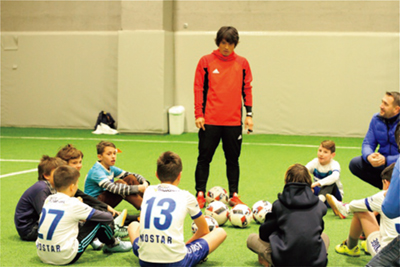 Coaching children in Mostar
Coaching children in Mostar(January, Mostar, Bosnia and Herzegovina, Photo: Little Bridge)
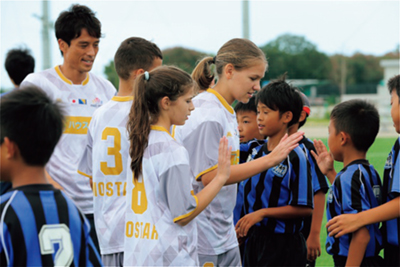 Football exchange between Japanese children and children from Mostar visiting Japan
Football exchange between Japanese children and children from Mostar visiting Japan(August, Sakai City, Photo: Little Bridge)
After I wrote about this research project in a newspaper column, I was contacted by staff from MOFA and JICA who suggested taking action to bring about the project. This gave our research project a chance of becoming a reality, which had only been a hypothetical plan.
When we first visited Mostar, the project site for our activities, the local people were skeptical; however, our repeated visits eventually convinced them and we were able to win their cooperation. I believe that it was also because the town of Mostar had already been a recipient of Japan's assistance through Japan's ODA program. With the help from the Grant Assistance for Cultural Grassroots Projects provided by the Government of Japan, facilities in the central part of the town were converted into a football ground laid with artificial turf and a club house, which would serve as an activity space for the academy.
In the summer of 2017, ten children from the academy visited Japan on a study tour, and joined a football exchange program with Japanese children of the same age group. I believe the interaction with those who speak a different language left an impression on the hearts of these children. There are still many challenges for the management of the academy, but we aim to further expand the scope of our activities.
(4) Exchange in the Intellectual Realm
A Japanese Studies
MOFA comprehensively supports a range of overseas research activities related to Japan's politics, economics, society and culture. In FY2017, MOFA sent visiting scholars, enhanced the collection of books on Japan, provided research grants, and provided support for organizing seminars and symposiums, to 70 institutions of Japanese studies in 34 countries and regions. Fellowship status was also granted to 143 researchers in Japanese studies from 39 countries and regions, including those who were granted in the previous year. This helped the researchers conduct research and study activities in Japan (including those scheduled in the 4th quarter of FY2017). MOFA also helps academic societies to promote network building among researchers and research institutions on Japan in different countries and regions.
B Intellectual Exchanges
MOFA implements intellectual exchange projects, putting emphasis on cooperative work and exchange with other countries. Specifically, MOFA implemented seminars and symposia on common international agendas, and programs to deepen the understanding of modern Japan at major universities overseas through the Japan Foundation. MOFA plans and supports exchange programs to strengthen relationships and deepen mutual understanding through holding conventions in various fields and at various levels in cooperation with NPOs and other institutions.
C U.S.-Japan Conference on Cultural and Educational Interchange (CULCON)
CULCON is a public-private binational advisory panel comprised of experts from Japan and the U.S. to discuss issues on educational and cultural exchanges between the two countries. Based on a proposal put forth at the 27th Plenary Session held in 2016, a new “Next Generation Task Force” was established in addition to the existing Arts Dialogue Committee, Education Review Committee, and Japanese Language Education Committee, with the aim of placing the focus on nurturing leaders who can play a key role in Japan-U.S. relations in the next generation. In October, a forum was held as a project under the Next Generation Task Force. External experts who are active in both Japan and the U.S. were invited to attend this forum in Tokyo. On the U.S. side, in response to a proposal raised by the Arts Dialogue Committee in 2016, an official website to publicize events related to Japanese art in the U.S., entitled “Arts Japan 2020,” was launched in June as a project under the Japan-United States Friendship Commission. In addition, the Education Review Committee has continued with initiatives towards achieving the goal of “doubling two-way student exchanges by the year 2020,” which was also mentioned in the Joint Statement at the Japan-U.S. Summit Meeting in 2014. All the working groups of CULCON are actively engaged in dialogue and activities.
D Cooperation with the United Nations University (UNU)
The Government of Japan recognizes the importance of the establishment of UNU, which contributes to the international community through study and research on global issues and human resources development. Japan invited UNU to set up its headquarters in Japan (Tokyo) and has provided various cooperation and support for 40 years. UNU, in collaboration with Japanese universities and research institutions, is engaged in international issues such as peace, development, and the environment on which Japan focuses and contributes to the dissemination of the policies of the Government of Japan. UNU established Master's and Doctoral Programmes in 2010 and 2012 respectively, and has made efforts to improve the quality of its global human resources development programs.
(5) Promotion of Japanese Language Education
There has been growing interest in the Japanese language among foreigners, especially the youth, as Japanese companies have been expanding their operations overseas along with the globalization of Japanese economic structure, and Japanese pop culture is prevailing worldwide. Further promotion of the Japanese language overseas leads to the creation of a favorable international environment for Japanese people and companies. Based on a survey conducted in FY2015, the JF has found that about 3.66 million people in 137 countries and regions overseas are currently learning the Japanese language. In 2017, the Japanese Language Proficiency Test offered by the JF was conducted in 286 cities of 81 countries and regions worldwide, and the number of applicants reached over 1 million for the first time (includes applicants taking the test in Japan). On the other hand, a shortage of Japanese education specialists to meet the interests and needs for the study of the Japanese language in many of these countries and regions is clearly becoming a significant challenge.
MOFA engages in accommodating the diverse needs of Japanese-language educational institutions overseas through the JF. Specifically, it dispatches Japanese language specialists overseas, provides training in Japan for Japanese teachers and foreign diplomats overseas, conducts preparatory Japanese courses for potential nurses and care workers before they come to Japan, which is based on the Economic Partnership Agreement (EPA) with Indonesia and the Philippines, encourages educational institutions and other organizations in each country and region to introduce Japanese language education, develops teaching materials, and promotes the “JF Japanese Language Education Standard” that corresponds with international standards for foreign language education. In addition to these efforts, the JF is also engaged in the promotion of Japanese language education overseas, through the utilization of IT such as learning support websites that use anime and manga as well as smartphone apps, and support for the activities of Japanese language educational institutions including the Japanese language teachers' associations in each country or region. As a result of these efforts, countries that are newly introducing Japanese language education as a part of the school curriculum have been emerging in recent years. For example, Japanese language education has been introduced as a part of secondary education in Laos in 2015, and primary education in Vietnam in 2016. At the Japan-India Summit Meeting held in September 2017, the leaders agreed to cooperate on expanding Japanese language education at universities and other institutions.
(6) Cultural Grant Assistance
The Government of Japan provides Cultural Grant Assistance, as part of Official Development Assistance (ODA) to promote culture and higher education in developing countries, thereby enhancing mutual understanding and friendly relations between Japan and such countries. The activities implemented in 2017 included four General Cultural Grant Assistance projects (total of around 470 million Japanese yen) and 21 Grant Assistance for Cultural Grassroots Projects (total of around 180 million Japanese yen). In 2017, General Cultural Grant Assistance put emphasis on the preservation of the cultural heritage and the broadcasting sector, while Grant Assistance for Cultural Grassroots Projects put emphasis on the fields of sports and the Japanese language.
 Completion ceremony for the Botswana judo hall (Sensei Itsubo Memorial Dojo) built through the Grant Assistance for Cultural Grassroots Projects. Judo gold medalist in the Rio Olympics Haruka Tachimoto attended the ceremony carrying a photograph of Mr. Itsubo, who had been teaching judo in Botswana but died in an accident (February 28, Botswana).
Completion ceremony for the Botswana judo hall (Sensei Itsubo Memorial Dojo) built through the Grant Assistance for Cultural Grassroots Projects. Judo gold medalist in the Rio Olympics Haruka Tachimoto attended the ceremony carrying a photograph of Mr. Itsubo, who had been teaching judo in Botswana but died in an accident (February 28, Botswana).(7) Cooperation through United Nations Educational, Scientific and Cultural Organization (UNESCO)
Japan is actively involved in various projects of UNESCO in the fields of education, science, and culture. UNESCO is the international organization of which post-war Japan first became a Member State in 1951. Since then, UNESCO has been cooperating with Japan in support of education, science, culture, etc., in developing countries.
In the field of culture, Japan offers active cooperation for the prevention and promotion of tangible and intangible cultural heritages of the world and support in the field of human resources development. At the same time, Japan actively participates in the international framework for safeguarding cultural heritage. As a part of such activities, Japan provides voluntary contributions to UNESCO aimed at the protection of tangible and intangible cultural heritages. With a part of these contributions, and with Japanese experts playing a leading role, Japan supports many projects for conservation and restoration of sites, such as Angkor in Cambodia, Kasubi Tombs in Uganda, and the restoration of cultural heritage in Nepal after the earthquake, while contributing to human resources development so that local people can protect their cultural heritage by themselves in the future. In particular, Japan provides continuous support for the preservation and restoration work of the ancient ruins of Angkor in Cambodia, which started in 1994. With regard to the safeguarding of intangible cultural heritage as well, the following projects have been implemented: the handing down of traditional performing arts such as music and dance, and traditional crafts in developing countries to the next generation; development of domestic institutions and capacity building of relevant parties to enhance the ability of countries to protect intangible cultural heritage by themselves.
In the field of education, Japan provides voluntary contributions with the aim of fostering human resources in developing countries. It also provides support for human resources development, mainly in the area of education, through promoting, for example, “Education for All (EFA)” led by UNESCO. As for the Education for Sustainable Development (ESD), Japan provided various support for the Aichi Nagoya Declaration adopted at the UNESCO World Conference on Education for Sustainable Development (ESD), co-hosted by UNESCO in Okayama City, Okayama Prefecture, and Nagoya City, Aichi Prefecture in November 2014. Moreover, in September 2016, the “Okayama ESD Project” nominated to UNESCO by Japan was awarded second UNESCO-Japan Prize on Education for Sustainable Development. In September 2017, three organizations from Jordan, UK, and Zimbabwe were awarded the third UNESCO-Japan Prize on Education for Sustainable Development.
Gender equality is another field that UNESCO is investing effort into. In addition to implementing a project for maintaining schooling rates among female students and improving learning effectiveness in Ethiopia (concluded in March 2017), a project to promote STEAM (science, technology engineering, art, and mathematics) education, with a focus on gender, is also being implemented in Sub-Saharan Africa through teacher education.
UNESCO is promoting organizational reform, decentralization and program reform, and Japan has continued providing support to UNESCO in these reform initiatives. The new Director-General of UNESCO Azoulay assumed office in November, and held a meeting with Foreign Minister Kono in December.
A World Heritage Convention
The World Heritage Convention aims to protect cultural heritages and natural heritages internationally as heritages to all of mankind. Japan became a party to the Convention in 1992 (as of December 2017, the number of parties to the Convention is 193). The sites listed on the “World Heritage List” are so-called “World Heritage” sites. They are classified into “Cultural Heritage” (monuments and remains), “Natural Heritage” (natural areas) and “Mixed Heritage” (having both cultural and natural elements). As of December 2017, a total of 1,073 World Heritage sites are inscribed on the World Heritage List. At the 41st session of the World Heritage Committee held in Krakow, Poland, in 2017, it was decided to inscribe the Sacred Island of Okinoshima and Associated Sites in the Munakata Region (Fukuoka), upon nomination by Japan, on the World Heritage List. This has raised the number of World Heritage sites in Japan to 21: 17 cultural heritage sites and four natural heritage sites.
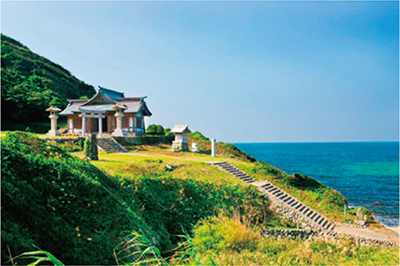 Okinoshima, one of the heritage sites that make up the Sacred Island of Okinoshima and Associated Sites in the Munakata Region (Photo: World Heritage Promotion Committee of the Sacred Island of Okinoshima and Associated Sites in the Munakata Region)
Okinoshima, one of the heritage sites that make up the Sacred Island of Okinoshima and Associated Sites in the Munakata Region (Photo: World Heritage Promotion Committee of the Sacred Island of Okinoshima and Associated Sites in the Munakata Region) Okitsu-miya Yohaisho, Munakata Taisha (one of the heritage sites that make up the Sacred Island of Okinoshima and Associated Sites in the Munakata Region) (Photo: World Heritage Promotion Committee of the Sacred Island of Okinoshima and Associated Sites in the Munakata Region)
Okitsu-miya Yohaisho, Munakata Taisha (one of the heritage sites that make up the Sacred Island of Okinoshima and Associated Sites in the Munakata Region) (Photo: World Heritage Promotion Committee of the Sacred Island of Okinoshima and Associated Sites in the Munakata Region)B Convention for the Safeguarding of the Intangible Cultural Heritage
The Convention for the Safeguarding of the Intangible Cultural Heritage aims to develop an international system for safeguarding intangible cultural heritage, such as traditional performing arts and traditional craftsmanship techniques (as of December 2017, the number of parties to the convention is 175). Japan, which has a wealth of experience in safeguarding domestic intangible cultural properties, has contributed actively by taking on a leading role in developing the Convention, laying down the main sections of the operational directives for the implementation of the Convention. As of December 2017, a total of 21 elements of intangible cultural heritage in Japan are inscribed on the Representative List of the Intangible Cultural Heritage of Humanity established in accordance with the Convention. These include: Nogaku Theatre, Ningyo Johruri Bunraku Puppet Theatre and Kabuki Theatre, which have been proclaimed by UNESCO as “Masterpieces of the Oral and Intangible Heritage of Humanity.” Japan is currently nominating “Raiho-shin: ritual visits of deities in masks and costumes,” as a candidate for inscription on the list of intangible cultural heritage of Japan.
C UNESCO Memory of the World Programme
The UNESCO Memory of the World Programme was established in 1992 to preserve and promote valuable historical documents. As of December 2017, 427 items have been inscribed. “Kozuke Sanpi” (the Three Cherished Stelae of Ancient Kozuke), as well as the “Joseon Tongsinsa/Chosen Tsushinshi: The History of Peace Building and Cultural Exchanges between Korea and Japan from the 17th to 19th Century,” submitted as a joint nomination by a joint organization of Japan and the ROK, were inscribed to the “Memory of the World” in October.
Moreover, as seen in the submission and inscription of the documents related to the Nanjing Massacre1 by organizations in China in October 2015, the emergence of political conflict due to unilateral submission and inscription based only on the assertions of one country, despite there being clear discrepancies between the views of the countries involved, is in violation of the founding principle of UNESCO of promoting friendly ties and mutual understanding among member countries. As such, Japan is continuing efforts to advance the review process. At a meeting of the Executive Board of UNESCO held in October 2017, a resolution was adopted to avoid the political tensions and improve the review process. At the inscription review held thereafter, the inscription of documents related to wartime “comfort women” was shelved in a bid to encourage dialogue between the relevant parties. In December, the secretariat announced that it will not be accepting new applications for the inscription to the “Memory of the World” in the immediate future.
- 1 The UNESCO Memory of the World Programme calls for access to the documents in question as the criteria for inscription. However, the browsing of documents related to the Nanjing Massacre is not permitted.
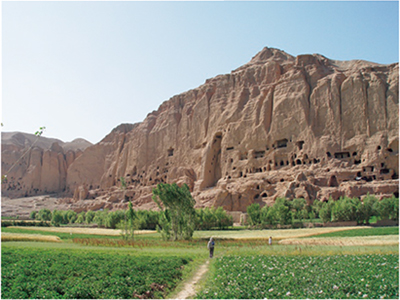 Landscape of Bamiyan
Landscape of BamiyanTwo majestic large Buddha statues stand quietly in the Bamiyan Valley, located in the central part of Afghanistan. For more than a thousand years, they have continued to fascinate many people. Even the Buddhist monk Xuanzhang, who once visited this land, had once lifted his eyes to these great Buddhas. Yet, they were destroyed in an instant by the Taliban in March 2001.
During the same year, the prolonged Afghanistan conflict came to an end, and Japan came quickly to the support of the Afghanistan people as they worked towards peace and recovery. In January 2002, Japan hosted the International Conference on Reconstruction Assistance to Afghanistan in Tokyo, which triggered the start of the recovery and reconstruction process thereafter. At the International Seminar on the Rehabilitation of Afghanistan's Cultural Heritage held in Kabul in May 2002, Japan announced that it will provide assistance for the conservation and repair of the Bamiyan cultural heritage through the UNESCO Japanese Funds-in-Trust for the Preservation of the World Cultural Heritage. The late Ikuo Hirayama, UNESCO Goodwill Ambassador (then President of Tokyo University of the Arts) who attended this seminar as a representative of Japan, suggested that it is important to preserve the damaged great Buddhas in their current state as a form of “negative heritage,” and at the same time, expressed that the rebuilding of the heritage should be a decision made by the Afghanistan people themselves in the future.
The Japanese experts who entered Kabul soon after the war ceased, in order to make preparations to launch Japan's assistance, first saw the National Museum of Afghanistan that had been destroyed and completely robbed of all traces of its former glory as the home to collections of the essence of Eastern and Western civilizations. However, a banner with the words “A nation stays alive when its culture stays alive,” written by hand, had been put up above the ruined entrance.
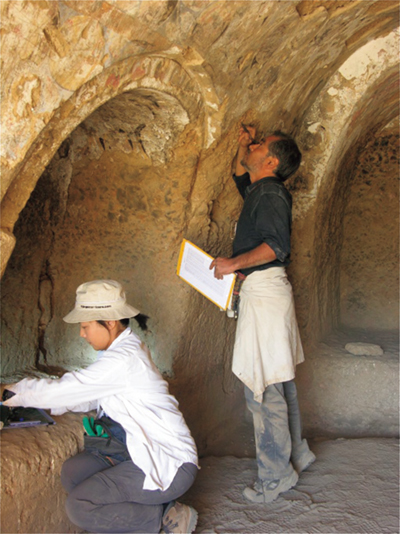 Restoring wall murals in the cave
Restoring wall murals in the caveTaking courage from these words, Japan launched its conservation and repair work on the Bamiyan heritage through UNESCO in 2003. Until today, it has provided financial assistance of approximately 700 million yen, as well as dispatched Japanese experts armed with an advanced level of expertise in fields such as archaeology and the conservation of valuable murals that remain on the caves surrounding the great Buddhas. These Japanese experts worked together with the people of Afghanistan on the site to conserve and repair the heritage. The project is now ongoing, facilitated by the collective capabilities of highly-skilled international experts not only from Japan, but also including Germany and Italy.
Based on these results, an international conference was held at the Tokyo University of the Arts in the fall of 2017 to discuss the future direction of the Bamiyan heritage. The focus was placed on the rebuilding of the Buddha in the eastern temple, which Afghanistan has expressed its wishes for. Experts from various countries as well as the relevant persons involved from Afghanistan exchanged views on the principles for the rebuilding of this cultural heritage, which is also a world heritage, as well as the methods that would be applied in the event that rebuilding actually takes place. Several concrete proposals were put forth at this conference, including Japan's suggestion to conserve the ruined site as it is while erecting a great Buddha statue on a separate site as a monument alongside with an integrated museum that exhibits and stores other artifacts discovered on the Bamiyan site, as well as the proposal from Germany to combine the individual fragments of the great Buddha and restoring it at its original location. A decision was made to review the respective proposals with the Government of Afghanistan takes the lead.
Japan offers its cooperation based on the approach that cultural heritage should be protected by the people of the country in the future. However, in light of the current security conditions in Afghanistan, it is becoming increasingly difficult for Japanese experts to cooperate with the local people at the site on repair and conservation work. Japan will continue to provide support with a view to the future, so that Afghanistan's culture will bloom once again on the foundations of peace and stability in the country.


